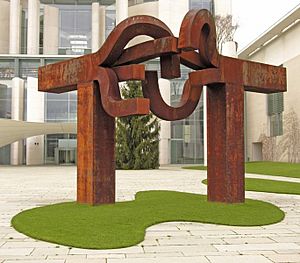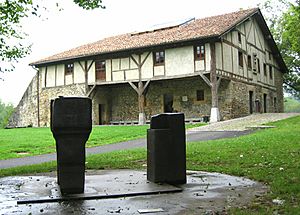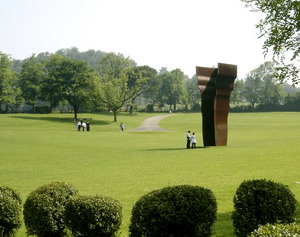Eduardo Chillida facts for kids
Quick facts for kids
Eduardo Chillida
|
|
|---|---|

Eduardo Chillida
|
|
| Born |
Eduardo Chillida Juantegu
10 January 1924 San Sebastián, Spain
|
| Died | 19 August 2002 (aged 78) |
| Occupation | Sculptor |
Eduardo Chillida Juantegui (born January 10, 1924 – died August 19, 2002) was a famous Spanish Basque sculptor. He was known for his large, powerful abstract artworks.
Contents
Becoming a Sculptor: Early Life and Career
Eduardo Chillida was born in San Sebastián, Spain, on January 10, 1924. His family owned a hotel, and he grew up nearby.
Before becoming an artist, Eduardo was a talented football player. He was a goalkeeper for Real Sociedad, a well-known team. Sadly, a serious knee injury ended his promising football career.
After football, he studied architecture at the University of Madrid. But he soon realized his true passion was art. In 1947, he left architecture to focus on art. He moved to Paris, France, in 1948. There, he started creating sculptures using plaster and clay.
In 1950, Eduardo married Pilar Belzunce. They later moved back to the San Sebastián area in Spain. He lived and worked there for the rest of his life.
Exploring Shapes: Chillida's Artworks
Chillida's early sculptures often showed human shapes, like torsos or busts. Later, his art became much larger and more abstract. He created many huge sculptures for public spaces. Even though his works looked abstract, Chillida called himself a "realist sculptor." He believed his art showed real feelings and ideas.
When he returned to the Basque Country in 1951, he stopped using plaster. Instead, he started working with forged iron. He even set up his own forge in his studio! He worked closely with blacksmiths to create his metal sculptures. He often added a special metal mix that made his sculptures turn a beautiful rust color as they aged.
From 1954 to 1966, Chillida created a series called Anvil of Dreams. In these works, he combined wood with metal forms. He also started making sculptures from alabaster in 1965.
Famous Public Sculptures
Chillida's sculptures quickly became well-known. In 1954, he made four large doors for the basilica of Arantzazu. He also carved a stone monument for Alexander Fleming, who discovered penicillin. This monument was placed in a park in San Sebastián.
By the 1970s, his steel sculptures were placed in important locations. These included the UNESCO headquarters in Paris and the World Bank offices in Washington, D.C.
His artworks, even though they are very big, often seem to move and have energy. For example, De Musica in the United States is an 81-ton steel sculpture. It has two tall pillars with "arms" that reach out but do not touch. Many of Chillida's works are inspired by his Basque background. He often gave his sculptures titles in the Basque language, Euskera.
His cast iron sculpture Topos V has been in Plaça del Rei, Barcelona, since 1986. Chillida also created many etchings, lithographs, and woodcuts. He even illustrated books.
The Monument to Tolerance in Fuerteventura
One of Chillida's big ideas was the Monument to Tolerance. This project involves digging a huge cave inside a mountain on the island of Fuerteventura. The cave would be 40 meters (131 feet) on each side. Chillida wanted visitors to feel the immense size of the space. He called it his "monument to tolerance."
This project has been planned since 1994. Local authorities decided to move forward with it, even with some environmental concerns.
Talking about Space: Chillida and Philosophy
In the 1960s, Eduardo Chillida had discussions with the German philosopher Martin Heidegger. They both explored the idea of "space" in their work. Heidegger believed that things themselves are "places" and that sculpture helps us understand this. Chillida said, "My whole Work is a journey of discovery in Space. Space is the liveliest of all, the one that surrounds us."
Chillida also talked about the difference between "experience" and "perception." He felt that "perception" was more about looking forward and growing. He said, "All of my work is the progeny of the question. I am a specialist in asking questions, some without answers." Other thinkers like Gaston Bachelard and Octavio Paz also wrote about Chillida's art.
Images for kids
-
Elogio del Horizonte (Eulogy to the Horizon), concrete (1989), Gijón, Spain
-
Toleranz durch Dialog, Münster, Germany
-
Haizearen orrazia San Sebastián, Spain
-
Elogi de l'aigua, Barcelona, Spain
-
Monumento (1971), Thyssen-Hochhaus, Düsseldorf, Germany
Seeing His Art: Exhibitions and Collections
Eduardo Chillida's art has been shown in many places around the world. His first solo exhibition was in Madrid in 1954. After that, he had over 100 one-man shows. He also took part in major international art events like the Venice Biennale. He won important awards, including the Carnegie Prize for sculpture in 1964.
Major museums around the world have collected Chillida's sculptures. These include the Museum of Modern Art in New York and the Tate Britain in London. The Museo Nacional Centro de Arte Reina Sofía in Madrid has a special collection of his work. Chillida even designed the museum's logo!
Chillida Leku: A Special Place for Art
In the early 1980s, Chillida and his wife bought an old Basque farmhouse and land near San Sebastián. They wanted to create a permanent home for his sculptures in a natural setting. This place opened in the 1990s as Chillida Leku. It's an open-air museum where visitors can walk among his artworks. Leku means 'place' in Basque. The museum closed for a while but reopened in 2019.
Awards and Recognition
Eduardo Chillida received many honors and awards for his amazing contributions to art. In 2002, the city of Vitoria-Gasteiz gave him its highest honor. He also received the Praemium Imperiale in Sculpture in 1991. Other awards include:
- (1998) Lifetime Achievement in Contemporary Sculpture Award
- (1987) Premio Príncipe de Asturias de las Artes
- (1985) Wolf Prize in Sculpture
See also
 In Spanish: Eduardo Chillida para niños
In Spanish: Eduardo Chillida para niños









